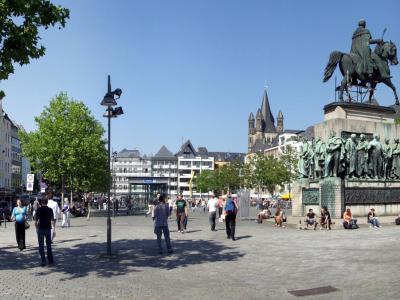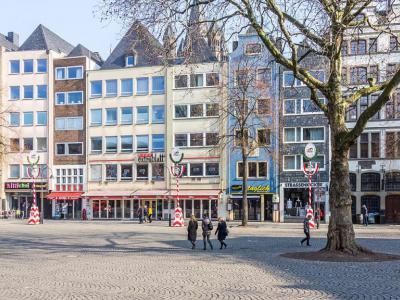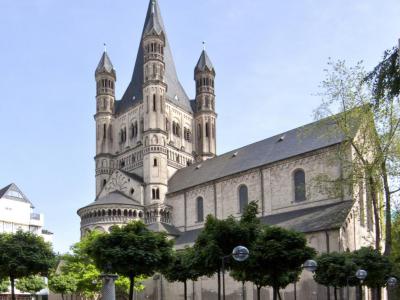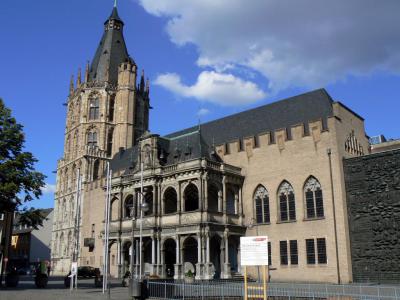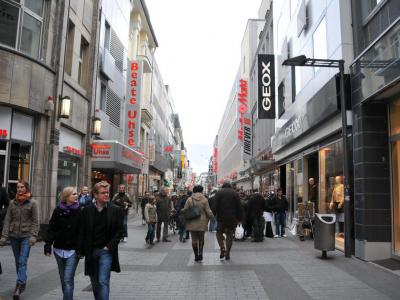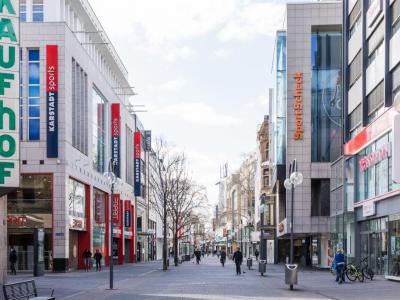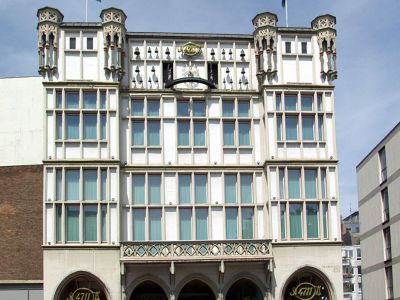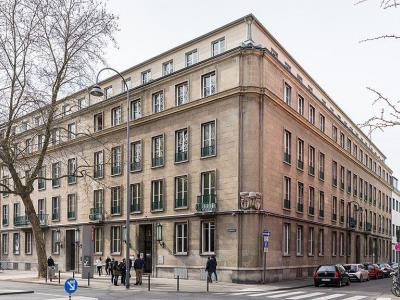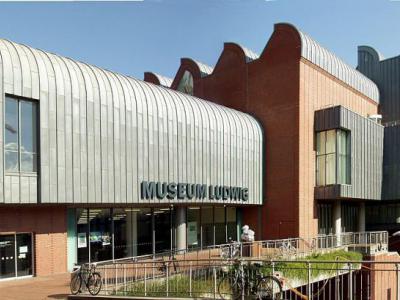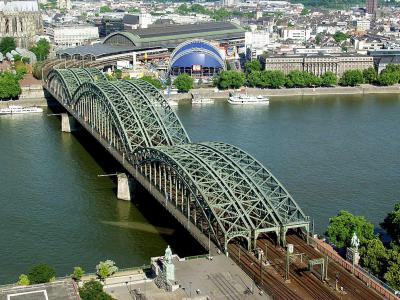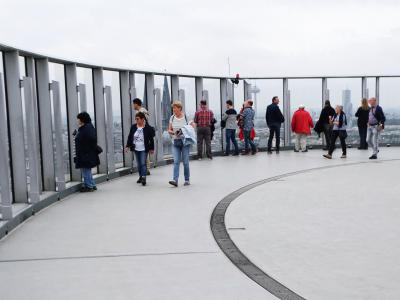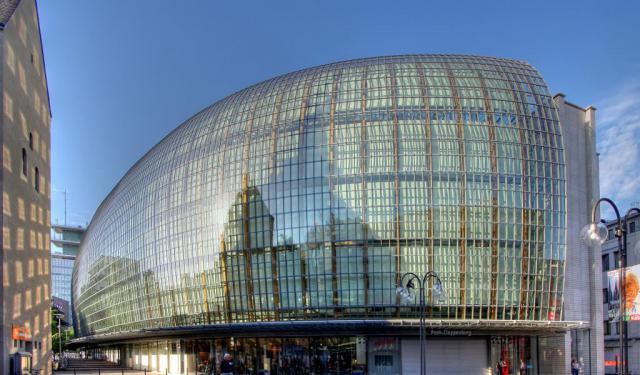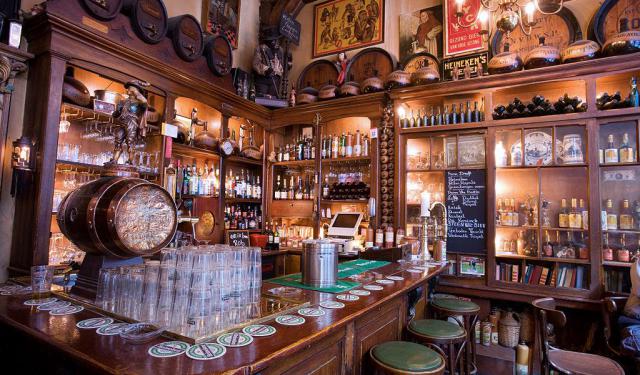
Cologne Introduction Walking Tour (Self Guided), Cologne
Cologne is one of Germany's oldest cities. It was founded as a Roman settlement on the Rhine in the first century, then known as the Colonia Claudia Ara Agrippinensium.
The name came from Agrippina the Younger, wife of Roman Emperor Claudius. She came from the area and petitioned the emperor to raise the status of her home to a Colonia--a city under Roman law. During the Roman period, it became the capital of the Lower Germany region.
After Roman Empire collapsed, Cologne came under the Frankish rule. The city became known simply as Colonia. English speakers call the city by its French translation, Cologne.
The city's location on major trade routes allowed Cologne to flourish in the Middle Ages. Cologne became a Holy Roman Empire free imperial city in 1475and was one of Europe's largest medieval and renaissance cities.
The French occupied Cologne again from 1794 until 1815 when it became part of Prussia. The British occupied it from 1918 to 1926.
World War II bombings heavily damaged Cologne and destroyed most ancient buildings. Post-war building has resulted in a diverse landscape of modern buildings and restored historic sites.
Cologne is a cultural hotspot with hundreds of galleries and over 30 museums. The Museum Ludwig features an impressive Picasso collection and focuses on modern and contemporary art. To gain insight into Nazi operations and see a Nazi victim memorial, visit the NS Documentation Center.
Visitors can explore historical shopping squares such as Hay Market and Alter Market and visit modern shopping areas like High Street and Schildergasse Street.
During the Reformation period in 16th century, the citizens of Cologne chose remain Catholic. As a result, the religious buildings in the city were spared the worst of the devastation suffered in the surrounding towns. Today Cologne is known for its restored twelve Romanesque Catholic churches. The Great St. Martin Church was built between 1150 and 1250 and was rebuilt after WWII. Don't miss Cologne's most iconic landmark, the Cologne Cathedral. This Gothic cathedral's impressive tower is 515 feet tall.
Take this self-guided walking tour to explore Cologne's most notable sights.
The name came from Agrippina the Younger, wife of Roman Emperor Claudius. She came from the area and petitioned the emperor to raise the status of her home to a Colonia--a city under Roman law. During the Roman period, it became the capital of the Lower Germany region.
After Roman Empire collapsed, Cologne came under the Frankish rule. The city became known simply as Colonia. English speakers call the city by its French translation, Cologne.
The city's location on major trade routes allowed Cologne to flourish in the Middle Ages. Cologne became a Holy Roman Empire free imperial city in 1475and was one of Europe's largest medieval and renaissance cities.
The French occupied Cologne again from 1794 until 1815 when it became part of Prussia. The British occupied it from 1918 to 1926.
World War II bombings heavily damaged Cologne and destroyed most ancient buildings. Post-war building has resulted in a diverse landscape of modern buildings and restored historic sites.
Cologne is a cultural hotspot with hundreds of galleries and over 30 museums. The Museum Ludwig features an impressive Picasso collection and focuses on modern and contemporary art. To gain insight into Nazi operations and see a Nazi victim memorial, visit the NS Documentation Center.
Visitors can explore historical shopping squares such as Hay Market and Alter Market and visit modern shopping areas like High Street and Schildergasse Street.
During the Reformation period in 16th century, the citizens of Cologne chose remain Catholic. As a result, the religious buildings in the city were spared the worst of the devastation suffered in the surrounding towns. Today Cologne is known for its restored twelve Romanesque Catholic churches. The Great St. Martin Church was built between 1150 and 1250 and was rebuilt after WWII. Don't miss Cologne's most iconic landmark, the Cologne Cathedral. This Gothic cathedral's impressive tower is 515 feet tall.
Take this self-guided walking tour to explore Cologne's most notable sights.
How it works: Download the app "GPSmyCity: Walks in 1K+ Cities" from Apple App Store or Google Play Store to your mobile phone or tablet. The app turns your mobile device into a personal tour guide and its built-in GPS navigation functions guide you from one tour stop to next. The app works offline, so no data plan is needed when traveling abroad.
Cologne Introduction Walking Tour Map
Guide Name: Cologne Introduction Walking Tour
Guide Location: Germany » Cologne (See other walking tours in Cologne)
Guide Type: Self-guided Walking Tour (Sightseeing)
# of Attractions: 12
Tour Duration: 2 Hour(s)
Travel Distance: 4.1 Km or 2.5 Miles
Author: audrey
Sight(s) Featured in This Guide:
Guide Location: Germany » Cologne (See other walking tours in Cologne)
Guide Type: Self-guided Walking Tour (Sightseeing)
# of Attractions: 12
Tour Duration: 2 Hour(s)
Travel Distance: 4.1 Km or 2.5 Miles
Author: audrey
Sight(s) Featured in This Guide:
- Heumarkt (Hay Market)
- Alter Markt (Old Market)
- Groß St. Martin (Great St. Martin Church)
- Historic Town Hall
- Hohe Strasse (High Street)
- Schildergasse Shopping Street
- 4711 House of Fragrances
- NS Documentation Center
- Kölner Dom (Cologne Cathedral)
- Museum Ludwig
- Hohenzollernbrücke (Hohenzollern Bridge)
- KölnTriangle Panorama (Triangle Observation Deck)
1) Heumarkt (Hay Market) (must see)
Tracing all the way back to Roman era, Cologne's Hay Market is one of Central Europe's oldest markets. In the Middle Ages, the Hay Market developed into a trading center. Back then, Hay Market and Old Market were originally one market known as Old Market. However, as time progressed, the market areas separated.
By the 13th century, Cologne's population has grown to over forty-thousand, one of the largest in Europe. Hay Market's prime location made it an ideal place for trade. Traders sold vegetables, fish, cheese, legumes, and spices in addition to grain and hay. A grain scale was added in 1492.
In addition to its commercial success, the square where the Hay Market operated had grown its aesthetic appeal. During the Renaissance period, Hay Market was considered one of the most beautiful city squares in Central Europe, often being compared to St. Marks in Venice. Today the brick-paved square are lined with well groomed trees and fancy restaurant, and is a lively place popular with tourists and locals alike.
In 1580, the Cologne stock exchange was established in the Hay Market square. The statue of Prussia's Friedrich Wilhelm III dominates Hay Market square. The equestrian statue was dedicated in 1878. In 1904, the main market hall was built.
Hay Market has ceased its operation a long time ago but today the square bearing its name is as popular as ever. It features several pubs and breweries as well as a good number of restaurants and cafes offer outside seating and excellent people-watching in the summer. In addition, the square is home to a festive Christmas market and an ice-skating rink in winter.
By the 13th century, Cologne's population has grown to over forty-thousand, one of the largest in Europe. Hay Market's prime location made it an ideal place for trade. Traders sold vegetables, fish, cheese, legumes, and spices in addition to grain and hay. A grain scale was added in 1492.
In addition to its commercial success, the square where the Hay Market operated had grown its aesthetic appeal. During the Renaissance period, Hay Market was considered one of the most beautiful city squares in Central Europe, often being compared to St. Marks in Venice. Today the brick-paved square are lined with well groomed trees and fancy restaurant, and is a lively place popular with tourists and locals alike.
In 1580, the Cologne stock exchange was established in the Hay Market square. The statue of Prussia's Friedrich Wilhelm III dominates Hay Market square. The equestrian statue was dedicated in 1878. In 1904, the main market hall was built.
Hay Market has ceased its operation a long time ago but today the square bearing its name is as popular as ever. It features several pubs and breweries as well as a good number of restaurants and cafes offer outside seating and excellent people-watching in the summer. In addition, the square is home to a festive Christmas market and an ice-skating rink in winter.
2) Alter Markt (Old Market)
The Old Market was once connected to the Hay Market. Today the square bearing its name has several Renaissance buildings, an attractive fountain, and a Christmas Market.
The Old Market square has hosted markets and a residential area since at least 922. The oldest original structure in the square dates to 1580. Many other historic houses and buildings were destroyed during World War II bombing attacks.
The 1371 Cologne Weaver Uprising took place in Old Market and Hay Market. The weavers guild and the city council continuously disagreed, and the conflict turned bloody. The city council had more manpower, however, and the weavers were arrested or forced to leave the city.
The iconic fountain features a statue of Jan von Werth completed in 1884. The legend behind the statue tells of a young girl Griet who rejected Jan, a poor peasant. Griet wanted a wealthier husband. Devastated by her rejection, Jan left to fight in the Thirty Years' War and became a powerful general. He returned to Cologne and saw Griet in the square selling fruits. Griet was filled with regret and exclaimed "Jan, who would have thought it?" to which he replied "Griet, the person who should have done it!" and turns away.
Today, visitors will find traditional German architecture and old monuments dedicated to the city’s founders on and around the square. The imposing old town hall is located on the west side of the square. Visitors can also see a strange sculpture Kallendresser near house number 24's roof. The sculpture depicts someone relieving himself in the gutter. It is thought that the sculpture is a political statement directed towards the city authority.
The Old Market square is a pedestrian-only area surrended by restaurants, bars, and ice-cream shops. The place is full of life well into the night.
The Old Market square has hosted markets and a residential area since at least 922. The oldest original structure in the square dates to 1580. Many other historic houses and buildings were destroyed during World War II bombing attacks.
The 1371 Cologne Weaver Uprising took place in Old Market and Hay Market. The weavers guild and the city council continuously disagreed, and the conflict turned bloody. The city council had more manpower, however, and the weavers were arrested or forced to leave the city.
The iconic fountain features a statue of Jan von Werth completed in 1884. The legend behind the statue tells of a young girl Griet who rejected Jan, a poor peasant. Griet wanted a wealthier husband. Devastated by her rejection, Jan left to fight in the Thirty Years' War and became a powerful general. He returned to Cologne and saw Griet in the square selling fruits. Griet was filled with regret and exclaimed "Jan, who would have thought it?" to which he replied "Griet, the person who should have done it!" and turns away.
Today, visitors will find traditional German architecture and old monuments dedicated to the city’s founders on and around the square. The imposing old town hall is located on the west side of the square. Visitors can also see a strange sculpture Kallendresser near house number 24's roof. The sculpture depicts someone relieving himself in the gutter. It is thought that the sculpture is a political statement directed towards the city authority.
The Old Market square is a pedestrian-only area surrended by restaurants, bars, and ice-cream shops. The place is full of life well into the night.
3) Groß St. Martin (Great St. Martin Church) (must see)
The Great St. Martin Church has a long and storied history. The current church is a Romanesque Catholic church built between 1150 and 1250. The church's most distinctive feature is its iconic tower which has shaped Old Town's skyline for centuries.
During Roman times, this site was an island in the Rhine River. The Romans built a chapel on this site, and another church was built during the 10th century.
The church was destroyed by fire in 1150, and a new church was commissioned. A tri-apsidal structure was built in 1172 and survived an 1185 fire. Another fire damaged the roofs of the four towers in 1378, and a storm in 1434 knocked the roofs from the towers.
During the 18th century, Baroque decorations were added to the church's interior. However, some church officials thought the decorations were too ornate and changed some elements.
In 1794, French forces occupied Cologne and remained for 20 years. Great St. Martin's monastery was disbanded in 1802, and the monks had to find other places to live. The abbey was used as French barracks before being demolished.
Extensive restoration work began in 1847. During World War II, the church was damaged and several parts of the church burned to the ground. The church was restored between 1948 and 1985.
Why You Should Visit:
Very handsome church exterior; very nicely located near the Rhine; very quiet and peaceful; very close to the old town restaurants.
Tip:
The entrance is slightly hidden at the rear. You may also go downstairs into the basement to see some old Roman foundations which the church was built on.
During Roman times, this site was an island in the Rhine River. The Romans built a chapel on this site, and another church was built during the 10th century.
The church was destroyed by fire in 1150, and a new church was commissioned. A tri-apsidal structure was built in 1172 and survived an 1185 fire. Another fire damaged the roofs of the four towers in 1378, and a storm in 1434 knocked the roofs from the towers.
During the 18th century, Baroque decorations were added to the church's interior. However, some church officials thought the decorations were too ornate and changed some elements.
In 1794, French forces occupied Cologne and remained for 20 years. Great St. Martin's monastery was disbanded in 1802, and the monks had to find other places to live. The abbey was used as French barracks before being demolished.
Extensive restoration work began in 1847. During World War II, the church was damaged and several parts of the church burned to the ground. The church was restored between 1948 and 1985.
Why You Should Visit:
Very handsome church exterior; very nicely located near the Rhine; very quiet and peaceful; very close to the old town restaurants.
Tip:
The entrance is slightly hidden at the rear. You may also go downstairs into the basement to see some old Roman foundations which the church was built on.
4) Historic Town Hall
The Historic Town Hall was built on the site of the Roman Praetorium, which was the Roman Governor of Germania Inferior's seat through 475. An earthquake in the eighth century destroyed the Praetorium.
Historic Town Hall is Germany's oldest city hall. Citizens formed a commune in the 11th century, and Cologne's coat of arms dates to 1114. The roofed hall building is City Hall's oldest building. The building dates to 1330 and features stone figures representing the Emperor, the Privileges, and the Nine Worthies.
The Gothic-style tower was constructed between 1407 and 1414. The five-story tower is 61 meters (200 feet) tall. The tower was Cologne's first secular high-rise and features 130 stone statues. The tower was damaged by World War II bombs but has been restored. The tower's carillon is played four times a day.
The Renaissance-style loggia, known as the Rathauslaube, was completed in 1573. The two-story arcade serves as an entrance to the main hall. In addition, the loggia's balcony was used for public speeches. The upper floor's parapet features a sculpture showing the struggle between a lion and the mayor Gryn.
The Spanischer Bau building was finished in 1615 and features Dutch Renaissance architecture. The name refers to Spanish delegates who were in residence during the Thirty Years War of 1618-1648. The Piazzetta was built after World War II.
Why You Should Visit:
Oldest town hall in Germany; a complex of different architectural styles, pleasant to see. The stone-paved area is perfect for a walk.
Tip:
Nice views from the other side of the river, along with the bridge and the cathedral.
Historic Town Hall is Germany's oldest city hall. Citizens formed a commune in the 11th century, and Cologne's coat of arms dates to 1114. The roofed hall building is City Hall's oldest building. The building dates to 1330 and features stone figures representing the Emperor, the Privileges, and the Nine Worthies.
The Gothic-style tower was constructed between 1407 and 1414. The five-story tower is 61 meters (200 feet) tall. The tower was Cologne's first secular high-rise and features 130 stone statues. The tower was damaged by World War II bombs but has been restored. The tower's carillon is played four times a day.
The Renaissance-style loggia, known as the Rathauslaube, was completed in 1573. The two-story arcade serves as an entrance to the main hall. In addition, the loggia's balcony was used for public speeches. The upper floor's parapet features a sculpture showing the struggle between a lion and the mayor Gryn.
The Spanischer Bau building was finished in 1615 and features Dutch Renaissance architecture. The name refers to Spanish delegates who were in residence during the Thirty Years War of 1618-1648. The Piazzetta was built after World War II.
Why You Should Visit:
Oldest town hall in Germany; a complex of different architectural styles, pleasant to see. The stone-paved area is perfect for a walk.
Tip:
Nice views from the other side of the river, along with the bridge and the cathedral.
5) Hohe Strasse (High Street)
High Street is one of Cologne's oldest streets. Today, it is a popular pedestrian-only shopping street.
High Street was originally a Roman Cardo Maximus street. This busy street was lined with shops and vendors. The forum with temples and the Praetorium was located along the street. In addition, two Roman legions had hospitals, canteens, and barracks along the street.
High Street has been central to Cologne's culture over the centuries. The street has held different names, such as Stone Street during the Middle Ages. During the French Occupation of 1795-1814, a French survey called the street "High Street" in reference to the High Porte on its southern end.
High Street became a busy shopping street during the 19th century. Today, visitors will find a wide range of shops. Don't miss visiting the famous chocolatier Stollwerck. Kids of all ages will love the massive Lego store. The street also features dozens of cafes and restaurants.
High Street was originally a Roman Cardo Maximus street. This busy street was lined with shops and vendors. The forum with temples and the Praetorium was located along the street. In addition, two Roman legions had hospitals, canteens, and barracks along the street.
High Street has been central to Cologne's culture over the centuries. The street has held different names, such as Stone Street during the Middle Ages. During the French Occupation of 1795-1814, a French survey called the street "High Street" in reference to the High Porte on its southern end.
High Street became a busy shopping street during the 19th century. Today, visitors will find a wide range of shops. Don't miss visiting the famous chocolatier Stollwerck. Kids of all ages will love the massive Lego store. The street also features dozens of cafes and restaurants.
6) Schildergasse Shopping Street
Schildergasse is Cologne's most visited shopping street and the busiest in Europe. According to a 2014 survey, 14,590 people walk the street every hour. Schildergasse is a pedestrian-only area and connects to High Street on its eastern end and the New Market on the western end.
Schildergasse dates to Roman times and was the Roman city's east to west street, or Decumanus Maximus. During the Middle Ages, the street housed many artists who painted coats of arms. The Schildergasse name originated from this time, as Schilder means signs.
The street features the Weltstadthaus, which looks like an enormous glass whale. The Weltstadthaus is home to the Peek & Cloppenburg clothing store. The impressive glass facade has 6800 individual panes.
Schildergasse has a variety of major department stores. Visitors will find H&M, Zara, and Galeria Kaufhof. In addition, there are shoe stores, fashion shops, sports shops, mobile phone shops, and perfume shops.
In addition to shops, the street is home to several landmarks. For example, visitors will find the Atoniterkirche, Cologne's oldest Protestant Church.
Why You Should Visit:
One of the most popular shopping streets in Europe, with seemingly endless possibilities to eat and drink, plus all the famous German, European and US brands.
Schildergasse dates to Roman times and was the Roman city's east to west street, or Decumanus Maximus. During the Middle Ages, the street housed many artists who painted coats of arms. The Schildergasse name originated from this time, as Schilder means signs.
The street features the Weltstadthaus, which looks like an enormous glass whale. The Weltstadthaus is home to the Peek & Cloppenburg clothing store. The impressive glass facade has 6800 individual panes.
Schildergasse has a variety of major department stores. Visitors will find H&M, Zara, and Galeria Kaufhof. In addition, there are shoe stores, fashion shops, sports shops, mobile phone shops, and perfume shops.
In addition to shops, the street is home to several landmarks. For example, visitors will find the Atoniterkirche, Cologne's oldest Protestant Church.
Why You Should Visit:
One of the most popular shopping streets in Europe, with seemingly endless possibilities to eat and drink, plus all the famous German, European and US brands.
7) 4711 House of Fragrances
The 4711 House of Fragrances is home to a museum and the original cologne store. 4711 refers to the building where fragrances were manufactured in 1792.
Johann Maria Farina first created a fragrance in the early 18th century. He named the fragrance "Water from Cologne" (in German "Eau de Cologne"). During the 18th century, the fragrance became more and more popular.
Wilhelm Mulhens was another fragrance producer who started manufacturing "miracle water" as a medicine. During the French Occupation at the end of the 18th century, a soldier listed the building where Mulhens created his fragrance as "4711" in a census.
In 1810, a Napoleonic law required all medicine producers to list their ingredients. Mulhens decided to repackage his product as a fragrance rather than disclose the secret ingredients.
Mulhens wanted to capitalize on the famous Farina name and bought the rights to the Farina name. However, this purchase was suspect and the Farina family sued Mulhens. Mulhens finally adopted the 4711 name in 1881.
The original 4711 building no longer exists. The new 4711 building houses the flagship 4711 store and a museum. Visitors can enjoy the Fragrance Fountain, which circulates the 4711 Original "Water from Cologne". In addition, visitors can tour exhibitions including old Rosoli bottles and historic perfume creations.
The 4711 building has 20 bells and plays three tunes every hour.
Tip:
You can create your own perfume or just look for different types of souvenirs for family and friends.
Johann Maria Farina first created a fragrance in the early 18th century. He named the fragrance "Water from Cologne" (in German "Eau de Cologne"). During the 18th century, the fragrance became more and more popular.
Wilhelm Mulhens was another fragrance producer who started manufacturing "miracle water" as a medicine. During the French Occupation at the end of the 18th century, a soldier listed the building where Mulhens created his fragrance as "4711" in a census.
In 1810, a Napoleonic law required all medicine producers to list their ingredients. Mulhens decided to repackage his product as a fragrance rather than disclose the secret ingredients.
Mulhens wanted to capitalize on the famous Farina name and bought the rights to the Farina name. However, this purchase was suspect and the Farina family sued Mulhens. Mulhens finally adopted the 4711 name in 1881.
The original 4711 building no longer exists. The new 4711 building houses the flagship 4711 store and a museum. Visitors can enjoy the Fragrance Fountain, which circulates the 4711 Original "Water from Cologne". In addition, visitors can tour exhibitions including old Rosoli bottles and historic perfume creations.
The 4711 building has 20 bells and plays three tunes every hour.
Tip:
You can create your own perfume or just look for different types of souvenirs for family and friends.
8) NS Documentation Center (must see)
The NS Documentation Center is located in the Cologne Gestapo's former headquarters. The Gestapo used the building from 1935 to 1945. The building is named EL-DE after the phonetic pronunciation of businessman Leopold Dahmen's initials. Dahmen rented the building to the Nazis while the building was still under construction. The Nazis built ten prison cells in the basement.
The Documentation Center has a memorial and exhibitions. The building's basement houses the "Gestapo Prison" memorial. The prison memorial is Germany's largest memorial to Nazi victims and one of the best-preserved Nazi detention sites. Visitors can see over 1,800 wall inscriptions left by prisoners.
The permanent exhibition focuses on the National Socialist era. Exhibits detail the Nazi power structure, Nazi propaganda, racism, and the genocide of Cologne's Jews. The exhibit also discusses Nazi opposition and resistance.
The NS Documentation Center has a library and conducts ongoing research into the Nazi era.
Tip:
Do get the audio guide; otherwise, you will miss a lot. Go downstairs first and make your way up. There are free lockers for bags.
The Documentation Center has a memorial and exhibitions. The building's basement houses the "Gestapo Prison" memorial. The prison memorial is Germany's largest memorial to Nazi victims and one of the best-preserved Nazi detention sites. Visitors can see over 1,800 wall inscriptions left by prisoners.
The permanent exhibition focuses on the National Socialist era. Exhibits detail the Nazi power structure, Nazi propaganda, racism, and the genocide of Cologne's Jews. The exhibit also discusses Nazi opposition and resistance.
The NS Documentation Center has a library and conducts ongoing research into the Nazi era.
Tip:
Do get the audio guide; otherwise, you will miss a lot. Go downstairs first and make your way up. There are free lockers for bags.
9) Kölner Dom (Cologne Cathedral) (must see)
Cologne Cathedral is a World Heritage Site and Germany's most visited landmark. Twenty thousand people visit each day. Cologne Cathedral is 157 meters (515) tall and the world's tallest twin-spired church. It is Europe's second-tallest church and the world's third tallest church. In addition, it is Northern Europe's largest Gothic church.
Construction began in 1248 and stalled between 1560 and 1840. Finally, the tower was completed in 1880.
The site has hosted Christian buildings since the fourth century. A seventh-century baptistery was located at the Cathedral's east end. The "Old Cathedral" stood here from 818 to 1248.
Cologne Cathedral was originally built to house the relics of the Three Kings. The eastern arm of the cathedral was built first. Construction on the west front continued in the 14th century. When construction stalled in 1473, a massive crane stayed in place for 400 years.
In the 19th century, the original facade plans were discovered, and officials decided to complete the cathedral. In 1860, the cathedral was completed 632 years after construction began. World War II bombs damaged the church, and repairs were carried out.
The black marble High Altar was installed in 1322. The Shrine of the Three Kings is the cathedral's biggest draw. The shrine holds the remains of the Three Wise Men. Work on the gilded shrine began in 1190.
The Gero Crucifix was created in the 10th century and is one of the oldest examples of a large free-standing crucifix. The wooden Milan Madonna dates to around 1290. An interior wall features a pair of stone tablets from the 13th century, which legalized Cologne's Jewish residents. The choir has original carved stalls that date to the 14th century.
The cathedral features 11 bells. The oldest bell was cast in 1418. When St. Peter's Bell was cast in 1922, it was the world's largest free-swinging bell.
Why You Should Visit:
Simply jaw dropping in size. You may never see another church so detailed and so large.
Tip:
Take a look at the beautiful mosaics on the floor in the Cathedral's rear part. You may also climb up to the top for a great view of Cologne, or go to underground parking to see the original foundations exposed there.
Construction began in 1248 and stalled between 1560 and 1840. Finally, the tower was completed in 1880.
The site has hosted Christian buildings since the fourth century. A seventh-century baptistery was located at the Cathedral's east end. The "Old Cathedral" stood here from 818 to 1248.
Cologne Cathedral was originally built to house the relics of the Three Kings. The eastern arm of the cathedral was built first. Construction on the west front continued in the 14th century. When construction stalled in 1473, a massive crane stayed in place for 400 years.
In the 19th century, the original facade plans were discovered, and officials decided to complete the cathedral. In 1860, the cathedral was completed 632 years after construction began. World War II bombs damaged the church, and repairs were carried out.
The black marble High Altar was installed in 1322. The Shrine of the Three Kings is the cathedral's biggest draw. The shrine holds the remains of the Three Wise Men. Work on the gilded shrine began in 1190.
The Gero Crucifix was created in the 10th century and is one of the oldest examples of a large free-standing crucifix. The wooden Milan Madonna dates to around 1290. An interior wall features a pair of stone tablets from the 13th century, which legalized Cologne's Jewish residents. The choir has original carved stalls that date to the 14th century.
The cathedral features 11 bells. The oldest bell was cast in 1418. When St. Peter's Bell was cast in 1922, it was the world's largest free-swinging bell.
Why You Should Visit:
Simply jaw dropping in size. You may never see another church so detailed and so large.
Tip:
Take a look at the beautiful mosaics on the floor in the Cathedral's rear part. You may also climb up to the top for a great view of Cologne, or go to underground parking to see the original foundations exposed there.
10) Museum Ludwig (must see)
Museum Ludwig is a modern art museum. The museum focuses on Pop Art, Abstract Art, and Surrealism. Museum Ludwig houses one of Europe's largest Picasso collections, in addition to works by Roy Lichenstein and Andy Warhol.
The museum's most popular artworks are Andy Warhol's Brillo Boxes, Roy Lichenstein's M-Maybe, and George Segal's Restaurant Window.
The museum is named after chocolatier Peter Ludwig, who endowed the City of Cologne with 350 modern artworks then valued at $45 million. The museum also houses a collection donated by Josef Haubrich. The museum continues to collect and exhibit contemporary art.
The museum has around 900 pieces of artwork by Picasso, making it the world's third-largest Picasso collection. Peter Ludwig also permanently loaned his collection of Russian avant-garde works. The collection includes 600 works from the early Russian avant-garde period and is the most extensive collection outside Russia.
Why You Should Visit:
Perhaps the most exciting modern art museum in Europe. Floor after floor, one room leads to another, and each work of art receives the needed space to come to life and impress you.
Tip:
Don't miss the bookstore at the entrance; it is not the usual souvenir shop, but a seriously good selection of art books in several European languages.
The museum's most popular artworks are Andy Warhol's Brillo Boxes, Roy Lichenstein's M-Maybe, and George Segal's Restaurant Window.
The museum is named after chocolatier Peter Ludwig, who endowed the City of Cologne with 350 modern artworks then valued at $45 million. The museum also houses a collection donated by Josef Haubrich. The museum continues to collect and exhibit contemporary art.
The museum has around 900 pieces of artwork by Picasso, making it the world's third-largest Picasso collection. Peter Ludwig also permanently loaned his collection of Russian avant-garde works. The collection includes 600 works from the early Russian avant-garde period and is the most extensive collection outside Russia.
Why You Should Visit:
Perhaps the most exciting modern art museum in Europe. Floor after floor, one room leads to another, and each work of art receives the needed space to come to life and impress you.
Tip:
Don't miss the bookstore at the entrance; it is not the usual souvenir shop, but a seriously good selection of art books in several European languages.
11) Hohenzollernbrücke (Hohenzollern Bridge) (must see)
The Hohenzollern Bridge is a railway and pedestrian bridge crossing the Rhine River. It was built to replace the old Cathedral Bridge that couldn't handle Cologne's increasing traffic. The Hohenzollern Bridge was completed in 1911 and functioned as a rail, vehicle, and pedestrian bridge.
The bridge was named after the House of Hohenzollern, who were German Emperors and rulers of Prussia. When the bridge was built, Cologne was part of the Rhine Provence of Prussia. Kaiser Wilhelm II inaugurated the bridge in 1911.
Equestrian statues of German emperors and Prussian kings flank each ramp. Statues representing Friedrich Wilhelm IV and Wilhem I are located on the Rhine's right bank. On the left bank, visitors will find Friedrich III and Wilhelm II statues.
During World War II, the Hohenzollern Bridge was one of Germany's most important bridges. Even though the bridge was subject to constant airstrikes, it remained functional. However, German engineers blew up the bridge as Allied forces approached on March 6, 1945.
The bridge was reconstructed between 1945 and 1959 and renovated in the 1980s. The cobblestones and tram tracks were preserved. Today, the bridge has walkways and cycle paths on both sides and a six-track railway.
Residents and tourists began adding love padlocks to the bridge in 2008. Couples add a padlock to the bridge and throw the key into the river to signify their love and commitment. By 2015, there were about 500,000 love locks on the bridge.
Why You Should Visit:
One of the best walks in Cologne, with great views of the city and the Cathedral.
Tip:
Visit in the evening, as you will see the whole city in lights and enjoy a completely different experience than daytime.
The bridge was named after the House of Hohenzollern, who were German Emperors and rulers of Prussia. When the bridge was built, Cologne was part of the Rhine Provence of Prussia. Kaiser Wilhelm II inaugurated the bridge in 1911.
Equestrian statues of German emperors and Prussian kings flank each ramp. Statues representing Friedrich Wilhelm IV and Wilhem I are located on the Rhine's right bank. On the left bank, visitors will find Friedrich III and Wilhelm II statues.
During World War II, the Hohenzollern Bridge was one of Germany's most important bridges. Even though the bridge was subject to constant airstrikes, it remained functional. However, German engineers blew up the bridge as Allied forces approached on March 6, 1945.
The bridge was reconstructed between 1945 and 1959 and renovated in the 1980s. The cobblestones and tram tracks were preserved. Today, the bridge has walkways and cycle paths on both sides and a six-track railway.
Residents and tourists began adding love padlocks to the bridge in 2008. Couples add a padlock to the bridge and throw the key into the river to signify their love and commitment. By 2015, there were about 500,000 love locks on the bridge.
Why You Should Visit:
One of the best walks in Cologne, with great views of the city and the Cathedral.
Tip:
Visit in the evening, as you will see the whole city in lights and enjoy a completely different experience than daytime.
12) KölnTriangle Panorama (Triangle Observation Deck) (must see)
The Triangle Observation Deck is on top of the KölnTriangle building. The KölnTriangle is 103 meters (339 feet) tall. The south facade features a double facade which allows for natural ventilation. The building is shaped in the form of a Realeaux triangle and has three convex arched sides around a round center.
The Triangle Observation Deck features panoramic views of Cologne. Its location on the Rhine River allows for excellent views of the Cologne Cathedral directly opposite. The observation deck has an outdoor area protected by glass panels. You can safely enjoy the view while feeling the power of wind and listening to the muted traffic below.
In addition to the fabulous view, visitors can enjoy delicious food at the rooftop restaurant.
The observation deck is open during the day and evening, and the views are stunning at dusk as the city's lights come on.
The Triangle Observation Deck features panoramic views of Cologne. Its location on the Rhine River allows for excellent views of the Cologne Cathedral directly opposite. The observation deck has an outdoor area protected by glass panels. You can safely enjoy the view while feeling the power of wind and listening to the muted traffic below.
In addition to the fabulous view, visitors can enjoy delicious food at the rooftop restaurant.
The observation deck is open during the day and evening, and the views are stunning at dusk as the city's lights come on.
Walking Tours in Cologne, Germany
Create Your Own Walk in Cologne
Creating your own self-guided walk in Cologne is easy and fun. Choose the city attractions that you want to see and a walk route map will be created just for you. You can even set your hotel as the start point of the walk.
Cologne's Architectural Landmarks Walking Tour
Around 75% of Cologne was destroyed by Allied bombing during World War II. Following such devastation, it meant that most of what was built immediately after the war came from the so-called “As quickly and cheaply as possible” school of architecture. Eventually, as the things settled, the architects were given the chance to build something that would really stand out.
Decades later, the... view more
Tour Duration: 2 Hour(s)
Travel Distance: 3.4 Km or 2.1 Miles
Decades later, the... view more
Tour Duration: 2 Hour(s)
Travel Distance: 3.4 Km or 2.1 Miles
Cologne Shopping Tour
Calling the shops, whilst in Cologne, is the thing you definitely should not miss! One of the most popular shopping destinations in Germany, this “cathedral” city abounds in malls, designer stores and various national and international brand outlets fit to impress anyone and let you shop till you drop! Some people even make special trips to Cologne just to stroll and buy things to their... view more
Tour Duration: 1 Hour(s)
Travel Distance: 1.5 Km or 0.9 Miles
Tour Duration: 1 Hour(s)
Travel Distance: 1.5 Km or 0.9 Miles
Cologne's Historical Churches Walking Tour
The beautiful and historically rich city of Cologne has been around for over 2,000 years. For centuries, it has been regarded as a very important religious center.
The Kölner Dom (Cologne Cathedral), one of its biggest attractions, is renowned as a symbol of Christianity and “a masterpiece of exceptional intrinsic value” (UNESCO World Heritage Site). The twelve Romanesque churches of... view more
Tour Duration: 2 Hour(s)
Travel Distance: 3.9 Km or 2.4 Miles
The Kölner Dom (Cologne Cathedral), one of its biggest attractions, is renowned as a symbol of Christianity and “a masterpiece of exceptional intrinsic value” (UNESCO World Heritage Site). The twelve Romanesque churches of... view more
Tour Duration: 2 Hour(s)
Travel Distance: 3.9 Km or 2.4 Miles
Beer House Walking Tour
In Cologne they say, "Kölsch is the only language you can drink." Brewed only here and nowhere else, Kölsch – a light beer, slightly bitter, bright yellow in color, and made of top-fermented yeast – is forbidden for production in any other part of Germany.
Each licensed brewery in the city makes its own variation of Kölsch, served traditionally in a tall, thin, cylindrical... view more
Tour Duration: 1 Hour(s)
Travel Distance: 1.8 Km or 1.1 Miles
Each licensed brewery in the city makes its own variation of Kölsch, served traditionally in a tall, thin, cylindrical... view more
Tour Duration: 1 Hour(s)
Travel Distance: 1.8 Km or 1.1 Miles
The Most Popular Cities
/ view all
